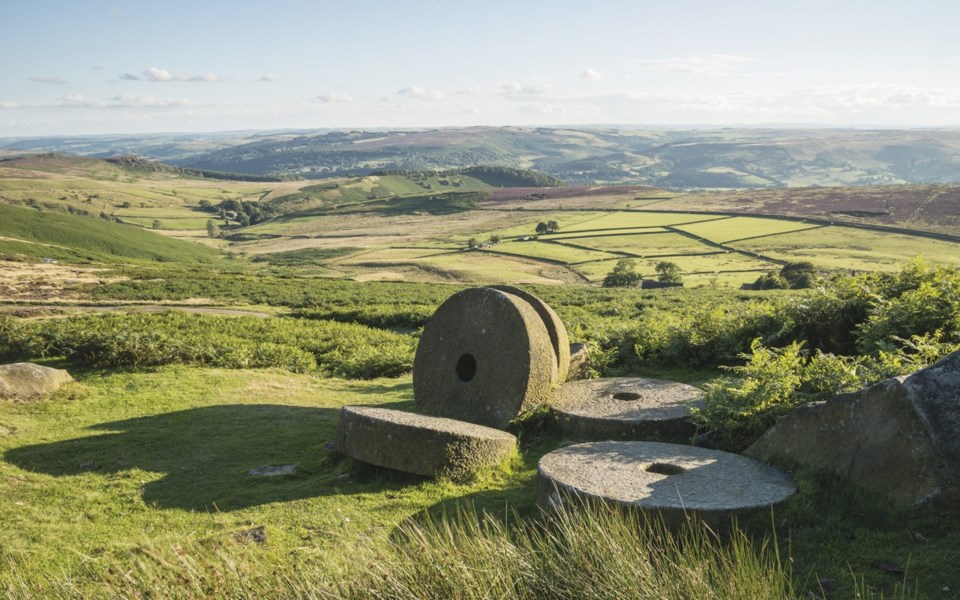As summer peters out, Labour Day weekend always stands as a bittersweet demarcation zone—the ultimate long weekend for getting out there and enjoying one last blissful and, hopefully, summery blast before getting back to the old grind.
The old grind: School. Work. Chores. Routine. Whatever you have to face over and over in regular, post-summer life, we have the mighty millstone to thank for that perfect expression describing the tedium of repeatedly doing any thankless task to attain a necessary goal. And the endgame doesn't get any more necessary—or repetitious—than fuelling ourselves with food.
This summer in Jordan's Black Desert, archeologists found teeny lumps of charred crumbs that turned out to be the earliest known examples of bread. They think one day they'll find bread dating back even further, but this particular flatbread was made some 14,000 years ago, around the same time that, according to the science journal, Nature, the peopling of the Americas started. It would take another 3,000 years before people learned to cultivate plants and farm.
The marvel for those archeologists, and just about anyone else, if you think about it, is that the early hunter-gatherers who made that ancient flatbread must have foraged for wild grains, one precious kernel at a time. Talk about tedious.
After painstakingly gathering them in the wilds, the small kernels of wild wheat, barley and oats, along with the tubers of a rush that were part of the ingredients, would have been ground manually between stones to render them fine enough to use. Given the huge amount of labour involved, this ancient bread was likely used for a feast or ritual.
Stones for grinding anything from spices, grains and rice to roasted coffee beans date back to Neolithic times and can be found in just about every culture.
Paul Natrall, chef/owner of Mr. Bannock, Vancouver's first aboriginal food truck, and a member of the Squamish Nation, says that his ancestors ground moss, lichen and ash, for leavening, with stones to produce their traditional style of flatbread. (See Pique Nov. 30, 2017 for more on Mr. Bannock.) And some aficianados will tell you that tequila and mezcal produced by grinding the necessary agave hearts in a large pit with a stone (a process called tahona) may be labour intensive but delivers the best results.
It took a few thousand years, but eventually we humans figured out faster, more efficient ways of grinding grain using big millstones run by water, wind or animals plodding round and round in circles, just like we're all about to do.
Recently, I was reminded again of the amazing role that millstones and other stones have played in our food supply when I read the label on one of the many bags of whole grains we have from Bob's Red Mill. (One more good reason to read your labels—they can send you down into all kinds of intriguing rabbit holes.)
Apparently, what sent Bob Moore and his wife, Charlee, down the rabbit hole of creating one of the best companies on the planet for whole grain products was the 1941 classic, John Goffe's Mill, which you can still find kicking around used bookstores. It was written by George Woodbury, the great-great-great-great-grandson of John Goffe himself.
Mr. Goffe, a colonial American soldier from New Hampshire, built his mill in 1774. George, an archeologist with Harvard's Peabody Museum, and his wife, Connie, decided to restore the old, broken-down mill after it had fallen into disrepair. In doing so, they discovered not everything was grim in getting back to the old grind.
The Woodburys, much like the Moores at Bob's Red Mill, latched onto a more satisfying, more meaningful lifestyle when they latched onto their millstones. They also took great pride in producing healthier, more satisfying food: Tasty, nutritious whole-grain products, including stoneground flour with the bran and germ intact, something that gets lost in modern, industrialized milling with its processing between giant steel rollers.
Some experts now place our modern, bleached, stripped-out and additive-laden processed flours at the root of several health issues.
"Absolutely, stoneground flours impart the most nutrients, texture and flavour," says Paula Lamming, co-owner of Whistler's popular Purebread bakery, which uses about 6,000 kg of flour each month—six different ones for breads plus two others for cake and pastry.
"(Stoneground flours) have a completely different texture and everything else. Some people may not like it, because most people who buy bread, go, OK, I want a white bread, or they want something super-grainy, and that's what the stoneground flours are good for because you have the bran in there.
"But it's definitely a personal taste, for sure," she says.
Two of Paula's favourite stoneground flours are spelt, which they use in their 100 per cent spelt loaf (spelt is a sub-species of common wheat that's been around since ancient times), and the buckwheat stoneground flour in their popular buckwheat sour cherry bread. Since buckwheat is actually a seed, it makes a very dense flour, which they lighten up with a mixture of flours.
If September means back to the grind for you, sounds like sandwiches made with some quality, fresh whole-grain breads are just what the doctor ordered for quick, nutritious lunches. Luckily, you won't have to grind your own flour.
Glenda Bartosh is an award-winning journalist who's trying to track down the fellow in Lillooet who used to produce stoneground flours.




